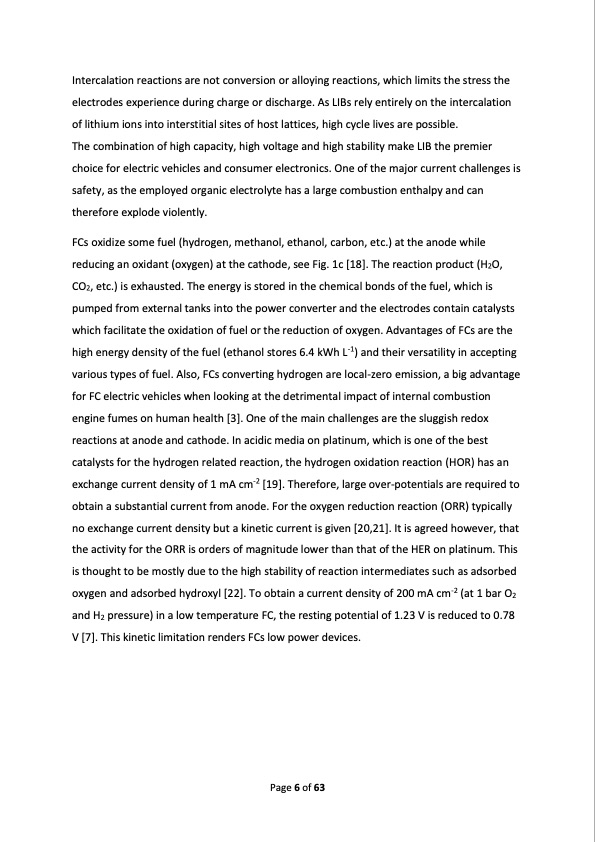
PDF Publication Title:
Text from PDF Page: 006
Intercalation reactions are not conversion or alloying reactions, which limits the stress the electrodes experience during charge or discharge. As LIBs rely entirely on the intercalation of lithium ions into interstitial sites of host lattices, high cycle lives are possible. The combination of high capacity, high voltage and high stability make LIB the premier choice for electric vehicles and consumer electronics. One of the major current challenges is safety, as the employed organic electrolyte has a large combustion enthalpy and can therefore explode violently. FCs oxidize some fuel (hydrogen, methanol, ethanol, carbon, etc.) at the anode while reducing an oxidant (oxygen) at the cathode, see Fig. 1c [18]. The reaction product (H2O, CO2, etc.) is exhausted. The energy is stored in the chemical bonds of the fuel, which is pumped from external tanks into the power converter and the electrodes contain catalysts which facilitate the oxidation of fuel or the reduction of oxygen. Advantages of FCs are the high energy density of the fuel (ethanol stores 6.4 kWh L-1) and their versatility in accepting various types of fuel. Also, FCs converting hydrogen are local-zero emission, a big advantage for FC electric vehicles when looking at the detrimental impact of internal combustion engine fumes on human health [3]. One of the main challenges are the sluggish redox reactions at anode and cathode. In acidic media on platinum, which is one of the best catalysts for the hydrogen related reaction, the hydrogen oxidation reaction (HOR) has an exchange current density of 1 mA cm-2 [19]. Therefore, large over-potentials are required to obtain a substantial current from anode. For the oxygen reduction reaction (ORR) typically no exchange current density but a kinetic current is given [20,21]. It is agreed however, that the activity for the ORR is orders of magnitude lower than that of the HER on platinum. This is thought to be mostly due to the high stability of reaction intermediates such as adsorbed oxygen and adsorbed hydroxyl [22]. To obtain a current density of 200 mA cm-2 (at 1 bar O2 and H2 pressure) in a low temperature FC, the resting potential of 1.23 V is reduced to 0.78 V [7]. This kinetic limitation renders FCs low power devices. Page 6 of 63PDF Image | Redox Flow Batteries Concepts Chemistries

PDF Search Title:
Redox Flow Batteries Concepts ChemistriesOriginal File Name Searched:
5870EAF5-2D70-44C8-A0A7-62D3A1462269.pdfDIY PDF Search: Google It | Yahoo | Bing
Salgenx Redox Flow Battery Technology: Salt water flow battery technology with low cost and great energy density that can be used for power storage and thermal storage. Let us de-risk your production using our license. Our aqueous flow battery is less cost than Tesla Megapack and available faster. Redox flow battery. No membrane needed like with Vanadium, or Bromine. Salgenx flow battery
| CONTACT TEL: 608-238-6001 Email: greg@salgenx.com | RSS | AMP |